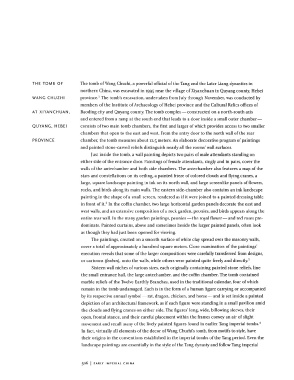Page 507 - The Golden Age of Chinese Archaeology: Celebrated Discoveries from the People’s Republic of China
P. 507
THE TOMB OF The tomb of Wang Chuzhi, a powerful official of the Tang and the Later Liang dynasties in
northern China, was excavated in 1995 near the village of Xiyanchuan in Quyang county, Hebei
1
WANG CHUZHI province. The tomb's excavation, undertaken from July through November, was conducted by
members of the Institute of Archaeology of Hebei province and the Cultural Relics offices of
AT XIYANCHUAN, Baoding city and Quyang county. The tomb complex — constructed on a north-south axis
and entered from a ramp at the south end that leads to a door inside a small outer chamber —
QUYANG, HEBE! consists of two main tomb chambers, the first and larger of which provides access to two smaller
chambers that open to the east and west. From the entry door to the north wall of the rear
PROVINCE chamber, the tomb measures about 12.5 meters. An elaborate decorative program of paintings
and painted stone-carved reliefs distinguish nearly all the rooms' wall surfaces.
Just inside the tomb, a wall painting depicts two pairs of male attendants standing on
either side of the entrance door. Paintings of female attendants, singly and in pairs, cover the
walls of the antechamber and both side chambers. The antechamber also features a map of the
stars and constellations on its ceiling, a painted frieze of colored clouds and flying cranes, a
large, square landscape painting in ink on its north wall, and large screenlike panels of flowers,
rocks, and birds along its main walls. The eastern side-chamber also contains an ink landscape
painting in the shape of a small screen, rendered as if it were joined to a painted dressing table
2
in front of it. In the coffin chamber, two large horizontal garden panels decorate the east and
west walls, and an extensive composition of a rock garden, peonies, and birds appears along the
entire rear wall. In the many garden paintings, peonies — the royal flower — and red roses pre-
dominate. Painted curtains, above and sometimes beside the larger painted panels, often look
as though they had just been opened for viewing.
The paintings, created on a smooth surface of white clay spread over the masonry walls,
cover a total of approximately a hundred square meters. Close examination of the paintings'
execution reveals that some of the larger compositions were carefully transferred from designs,
or cartoons (fenben), onto the walls, while others were painted quite freely and directly. 3
Sixteen wall niches of various sizes, each originally containing painted stone reliefs, line
the small entrance hall, the large antechamber, and the coffin chamber. The tomb contained
marble reliefs of the Twelve Earthly Branches, used in the traditional calendar, four of which
remain in the tomb undamaged. Each is in the form of a human figure carrying or accompanied
by its respective annual symbol — rat, dragon, chicken, and horse — and is set inside a painted
depiction of an architectural framework, as if each figure were standing in a small pavilion amid
the clouds and flying cranes on either side. The figures' long, wide, billowing sleeves, their
open, frontal stance, and their careful placement within the frames convey an air of slight
movement and recall many of the lively painted figures found in earlier Tang imperial tombs. 4
In fact, virtually all elements of the decor of Wang Chuzhi's tomb, from motifs to style, have
their origins in the conventions established in the imperial tombs of the Tang period. Even the
landscape paintings are essentially in the style of the Tang dynasty and follow Tang imperial
506 E A R L Y I M P E R I A L CHIN A

